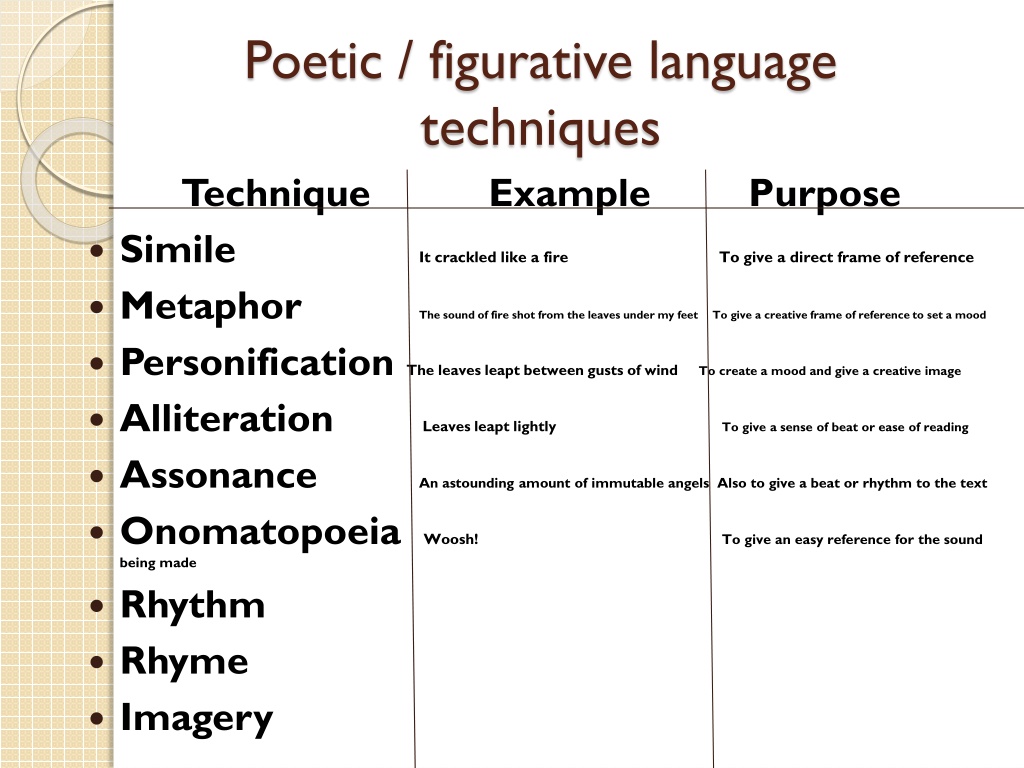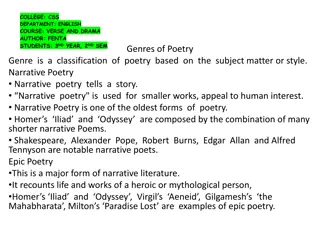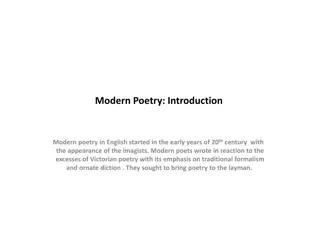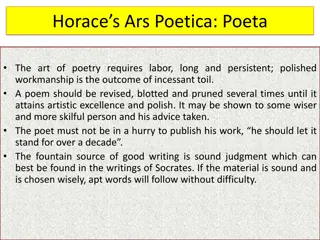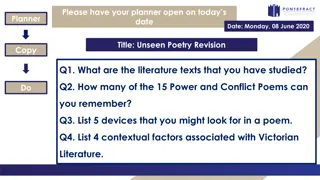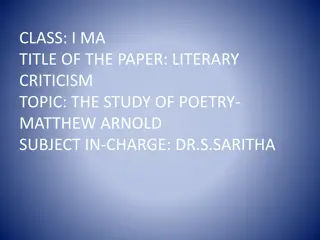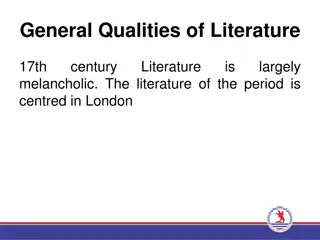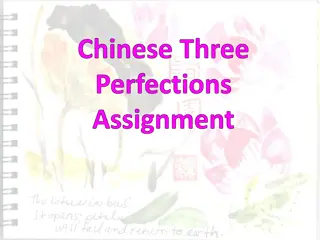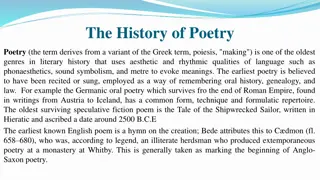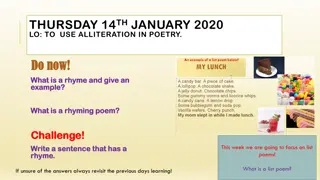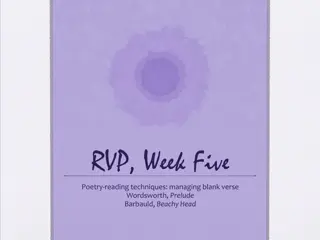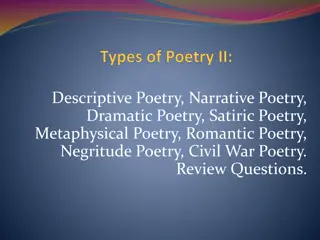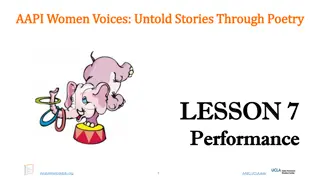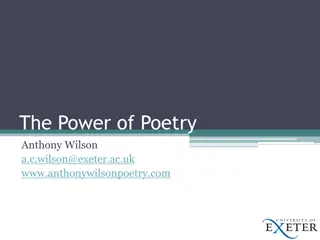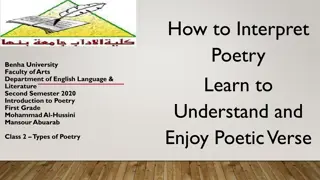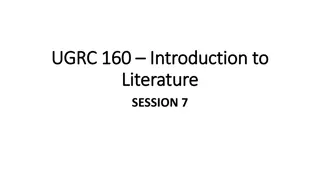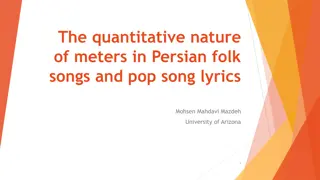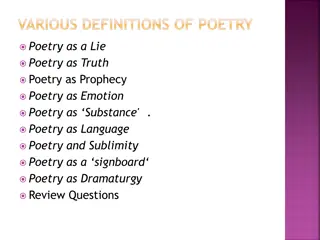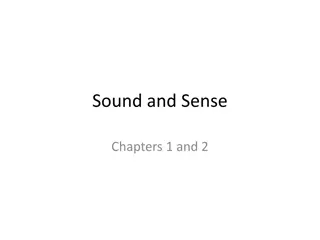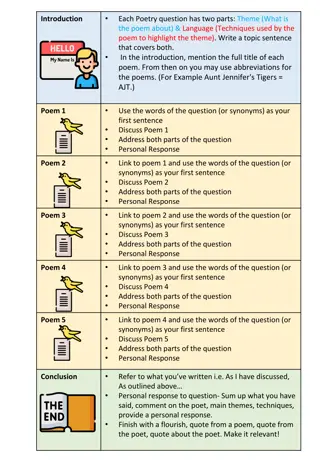Language Techniques in Poetry
Delve into the art of poetic expression through various language techniques such as simile, metaphor, personification, and more. Uncover how writers utilize these tools to create vivid imagery, evoke emotions, and enhance the overall impact of their work.
Download Presentation

Please find below an Image/Link to download the presentation.
The content on the website is provided AS IS for your information and personal use only. It may not be sold, licensed, or shared on other websites without obtaining consent from the author.If you encounter any issues during the download, it is possible that the publisher has removed the file from their server.
You are allowed to download the files provided on this website for personal or commercial use, subject to the condition that they are used lawfully. All files are the property of their respective owners.
The content on the website is provided AS IS for your information and personal use only. It may not be sold, licensed, or shared on other websites without obtaining consent from the author.
E N D
Presentation Transcript
Poetic / figurative language techniques Technique Example Simile Metaphor Personification The leaves leapt between gusts of wind To create a mood and give a creative image Alliteration Leaves leapt lightly Assonance Onomatopoeia Woosh! being made Rhythm Rhyme Imagery Purpose It crackled like a fire To give a direct frame of reference The sound of fire shot from the leaves under my feet To give a creative frame of reference to set a mood To give a sense of beat or ease of reading An astounding amount of immutable angels Also to give a beat or rhythm to the text To give an easy reference for the sound
What poetic techniques can you identify in this poem? The Eagle He clasps the crag with crooked hands; Close to the sun in lonely lands, Ring'd with the azure world, he stands. by Alfred, Lord Tennyson The wrinkled sea beneath him crawls; He watches from his mountain walls, And like a thunderbolt he falls. crooked hands This is a metaphor being used to give a creative view on the way a birds feet look
More language techniques Work in pairs to explain the following techniques? Give an example of each and explain why writers use them? Hyperbole Imperatives Rhetorical and interrogative questions Colloquial language Repetition Clich Superlative Euphemism Pun 10. Anecdote 11. Statistics 12. Personal pronouns 13. Listing 14. Emotive words and language 15. Examples 16. Informal language 17. Repetition 18. Short sentences 19. Alliteration 20. Antonyms and synonyms 21. Jargon 22. Slang 1. 2. 3. 4. 5. 6. 7. 8. 9.
Poetry work in pairs to answer these questions 1. Identify the specific language feature used in 'your ploughs like the fingernails of a woman'. Explain the effect the author is trying to achieve. It is trying to get people to imagine the pain that is caused by having your face clawed at by fingernails The Womb Your fires burnt my forests leaving only the charred bones of totara rimu and kahikatea 2. Explain how you can tell that this poem is a New Zealand poem. Quote evidence to support your answer. You can tell that it is a New Zealand poem because it has references to words and things that would only appear in New Zealand s culture Your ploughs like the fingernails of a woman scarred my face It seems I became a domestic giant 3. Identify the language feature in the sentence, 'I suck on your bodies as if they were lollipops'. Metaphor But in death you settlers and farmers return to me and I suck on your bodies as if they were lollipops 4. Explain why the language feature is effective in showing the land's attitude towards the settlers and farmers. It is effective because it shows a form of spite towards the farmers, which is what the land feels 5. Explain the line 'I am the land / the womb of life and death'. The line means that the speaker is the land, and that be it life or death, the land will support it. I am the land the womb of life and death Ruamoko the unborn God rumbles within me and the fires of Ruapehu still live 6. Identify the language feature used in 'rumbles within me', and explain what is suggested by the word 'rumbles'. Imagery. The word suggests that the thing is alive and it puts the idea that it is strong or powerful. Apirana Taylor
Prose - Pair discussion and work Extract from Shadows on our Skin. By the time Joe was let out of school the town was beginning to lose its colour. The rows of houses up the hill behind had the look of cardboard cut- outs against the draining sky. The wind that blew up the valley was cold and the day's dust and several crisp bags played dismally around Joe's feet as he walked along. Down below him in the distance a couple of shots were fired and then there was silence. The street lamps were flowering and people had not yet drawn their curtains so the dusk glittered. He stopped by a long low wall and put his school bag down on it. His mother hated him to loiter. A seagull drifted on the wind, out too late for safety. It was being blown away from the river back towards the hills. With an effort it moved its wings and turned steeply, setting off for home again. Joe picked up his school bag and took the hint. He turned off the main road down the hill, past a row of derelict cottages, the windows frightening holes. He began to run. This stretch of road always put fear in him. Around the corner a couple of men were strolling casually. Joe slowed his feet. He always felt that to run for no good reason made other people nervous. One of the men laughed at some joke. Joe sauntered past them.
Reflect on the writing and answer these questions: Explain in your own words the similarities between Joe and the seagull. They were both out at a time that they shouldn t be and they both realised that they should return for their own safety Explain in your own words the metaphor 'the street lamps were flowering'. It means that the street lamps were turning on in a way reminiscent of flowers flowering Explain what the word 'sauntered' means and explain why Joe moved in this way. Sauntered means that the person is walking slowly and casually, he is doing this as to not raise suspicion Describe the mood of the passage and explain how the writer conveys that mood. The mood of the passage is slightly lazy, unsettling, and with a sense of danger
Parts of Speech: match the term & definition Proper noun 2. Common noun 3. Collective noun 4. Abstract noun 5. Pronoun 6. Verb 7. Adjective 8. Adverb 9. Conjunction 10. Preposition 11. Article 12. Synonym 13. Antonym 14. Interjection a) b) c) d) e) a joining word - 9 a word that describes - 7 a word that has a similar meaning - 12 a word that has the opposite meaning - 13 a word that names a person, place or important event. - 1 a word used to describe a group of things - 3 a word used to describe something that can t usually be seen such as a feeling - 4 an action or doing word - 6 describes a verb - 8 names an everyday object - 2 shows surprise - 14 shows the position - 10 m) used in place of a noun - 11 n) used to indicate nouns and to specify their application. - 5 1. f) g) h) i) j) k) l)
